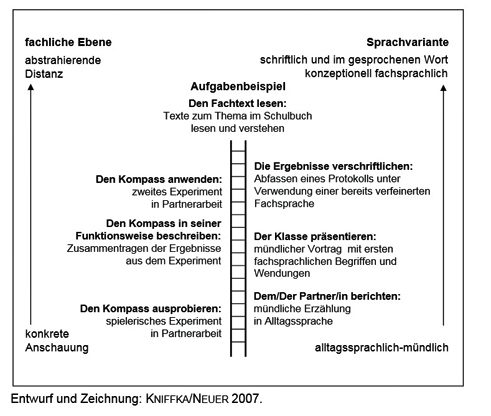An Interview with Gabriele Kniffka
“Scaffolding is a linguistic framework.”

When learning a specialist subject it is necessary to use specific language skills, alongside the specialist language content. However, children from educationally deprived backgrounds or those with German as a second language often have difficulties. Scaffolding is a good technique to make specialist subjects more linguistically accessible.
By Marguerite Seidel
Prof. Kniffka, what does scaffolding actually mean?
Scaffolding is all about linguistically supporting the teaching of specialist subjects, for example, mathematics, geography or history - the focus, however, still remains on the subject matter. The English term “scaffolding” is used to describe the process used to make the subject matter more linguistically accessible. This process enables a not so competent speaker to express something in words, which he, up to that point, had not been able to do alone.
Why is this linguistic training so important for the teaching of specialist subjects?
 Prof. Dr. Gabriele Kniffka
| Photo (detail): © Private
Language competence and academic success are closely linked. At school, so-called literacy skills are required. If a pupil does not have them, his performance suffers. This has been demonstrated over and over again in all the major school performance studies, such as PISA. This mainly affects children from educationally deprived backgrounds and children from an immigration background, who speak a different language at home to the one spoken at school. The linguistic environment in the parents' home is the key to language competence. If the children hear no or only a few instructions or explanations in the German-language at home in the parents’ house, this affects the language skills of the children. This might, for example, prevent them from understanding the wording of the task to be done in mathematics. Apart from this, however, each school subject has its own specialist language, specialist vocabulary, specialist methods of thinking and working. Conventional German language lessons cannot ensure the development of these literacy skills alone. Training in the specialist language of the subject is the task of the subjects themselves. This will enable schools to give all children a better chance of academic success.
Prof. Dr. Gabriele Kniffka
| Photo (detail): © Private
Language competence and academic success are closely linked. At school, so-called literacy skills are required. If a pupil does not have them, his performance suffers. This has been demonstrated over and over again in all the major school performance studies, such as PISA. This mainly affects children from educationally deprived backgrounds and children from an immigration background, who speak a different language at home to the one spoken at school. The linguistic environment in the parents' home is the key to language competence. If the children hear no or only a few instructions or explanations in the German-language at home in the parents’ house, this affects the language skills of the children. This might, for example, prevent them from understanding the wording of the task to be done in mathematics. Apart from this, however, each school subject has its own specialist language, specialist vocabulary, specialist methods of thinking and working. Conventional German language lessons cannot ensure the development of these literacy skills alone. Training in the specialist language of the subject is the task of the subjects themselves. This will enable schools to give all children a better chance of academic success.
Basically in all subjects. The learning of new content goes hand in hand with the acquisition of new language. For example, in the subject of history they talk about “feudal lords”. These are not just words, behind them is a comprehensive concept, which must be learned and understood. Or take the example of mathematics, the children come across the term “flat angles”. The word “flat” is perhaps known from their everyday language, but in geometry it has a different connotation. In the classroom, language exercises are also called for, which have to be practiced, such as arguing a point, describing something, explaining, and summarising. This promotion of linguistic competence can be supported by means of scaffolding techniques.
What should I do as a teacher to develop such a support system?
The Australian linguistics and education researcher, Pauline Gibbons, who helped to develop the scaffolding process, differentiates between two areas: lesson planning and teaching interaction. When planning the lessons, the teacher first analyses the material to be used: What is the subject? What language practices, structures, or words are the pupils required to know? These requirements are then matched to the pupils’ current language and knowledge levels. This is the basis for establishing the specialist subject and linguistic objectives of the lesson or of a series of lessons. The linguistic and specialist subject objectives are thus linked to one another. It can then be decided what help the pupils need to achieve these objectives.
What form does this teaching interaction take, or, as the case may be, the everyday practice in lessons?
 New Scaffolding Compass
| Photo (detail): © Kniffka/Neuer
One possible approach would be to move from the concrete to the abstract and, on the linguistic level, from everyday language to the language required in the specialist subject. For example, in the geography lesson the students are to learn how a compass works as one of the goals of the specialist subject’s content. The linguistic goal is to be able to describe the compass in all its component parts. The pupils first work in pairs, experimenting with the compass and describing what they can see in their everyday language. The next step is to present their results to the rest of the class. This is when they need to use more accurate language, because they are no longer holding the compass in their hands. In this phase the teacher introduces technical terms: the “wind rose” or the “compass needle”. In this case, scaffolding means that the things I have learned and understood in my everyday language are now being lexically enhanced. In the same way, further experimentation and sentence structures could be provided. In the end, the pupils should be able to read and understand a textbook on the subject of compasses, or even to write their own texts depending on their age. Scaffolding is designed to enable students to become more independent in the medium or long term – scaffolding, therefore, is supposed to lead to itself becoming superfluous.
New Scaffolding Compass
| Photo (detail): © Kniffka/Neuer
One possible approach would be to move from the concrete to the abstract and, on the linguistic level, from everyday language to the language required in the specialist subject. For example, in the geography lesson the students are to learn how a compass works as one of the goals of the specialist subject’s content. The linguistic goal is to be able to describe the compass in all its component parts. The pupils first work in pairs, experimenting with the compass and describing what they can see in their everyday language. The next step is to present their results to the rest of the class. This is when they need to use more accurate language, because they are no longer holding the compass in their hands. In this phase the teacher introduces technical terms: the “wind rose” or the “compass needle”. In this case, scaffolding means that the things I have learned and understood in my everyday language are now being lexically enhanced. In the same way, further experimentation and sentence structures could be provided. In the end, the pupils should be able to read and understand a textbook on the subject of compasses, or even to write their own texts depending on their age. Scaffolding is designed to enable students to become more independent in the medium or long term – scaffolding, therefore, is supposed to lead to itself becoming superfluous.
Scaffolding techniques can also be used successfully in classes that teach language as a foreign and second language. Preparatory classes are not primarily intended to teach everyday German. They prepare the students for their role as a learner in a regular teaching situation. Once there, they have to describe tables, to acquire specialist knowledge from texts and learn how to argue. On the basis of authentic lesson content in schools, this can be systematically introduced in the preparatory classes.
Can you give us an example of this?
Let us take, for example, “chunks”, which are typical of beginners’ lessons, i.e. small blocks of speech such as “I come from ... / He comes from ...”. The students can use these in geography, for example, when they have to describe a simple table listing the origins of certain imported goods or in the creation of a thematic world map. They can research in their mother tongue where cocoa or strawberries are cultivated and then present the results on a world map with the aid of a little linguistic support in German – “Kakao kommt aus ….” (Cocoa comes from ...). In this way, content and working methods required at secondary school level 1 can be developed in a simple way and then transferred from the pupils’ everyday language to the linguistic requirements at school.
Yes, lesson preparation is much more complex. Teaching itself also progresses more slowly, but it is more sustainable. The students achieve better results.
Do teachers need special training to work with scaffolding techniques, for example, when teaching German as a second language?
I would recommend further training courses in this area. In my experience, teachers of specialised subjects who are not language teachers have a hard time identifying the linguistic requirements. A lot of practice is also required for the formulation and linking of the linguistic objectives with those of the specialised subject.
What development potential do you envisage for scaffolding?
Those teachers who have tried out scaffolding and experienced success are as a rule enthusiastic about it. However, the approach has not yet been adequately embedded in school curricula, schoolbooks and in teacher training courses. Although syllabuses stipulate that content must be conveyed in an appropriate way to the addressee, these guidelines are often still unspecific when it comes to the way they are to be implemented.
Scaffolding is all about linguistically supporting the teaching of specialist subjects, for example, mathematics, geography or history - the focus, however, still remains on the subject matter. The English term “scaffolding” is used to describe the process used to make the subject matter more linguistically accessible. This process enables a not so competent speaker to express something in words, which he, up to that point, had not been able to do alone.
Why is this linguistic training so important for the teaching of specialist subjects?
 Prof. Dr. Gabriele Kniffka
| Photo (detail): © Private
Language competence and academic success are closely linked. At school, so-called literacy skills are required. If a pupil does not have them, his performance suffers. This has been demonstrated over and over again in all the major school performance studies, such as PISA. This mainly affects children from educationally deprived backgrounds and children from an immigration background, who speak a different language at home to the one spoken at school. The linguistic environment in the parents' home is the key to language competence. If the children hear no or only a few instructions or explanations in the German-language at home in the parents’ house, this affects the language skills of the children. This might, for example, prevent them from understanding the wording of the task to be done in mathematics. Apart from this, however, each school subject has its own specialist language, specialist vocabulary, specialist methods of thinking and working. Conventional German language lessons cannot ensure the development of these literacy skills alone. Training in the specialist language of the subject is the task of the subjects themselves. This will enable schools to give all children a better chance of academic success.
Prof. Dr. Gabriele Kniffka
| Photo (detail): © Private
Language competence and academic success are closely linked. At school, so-called literacy skills are required. If a pupil does not have them, his performance suffers. This has been demonstrated over and over again in all the major school performance studies, such as PISA. This mainly affects children from educationally deprived backgrounds and children from an immigration background, who speak a different language at home to the one spoken at school. The linguistic environment in the parents' home is the key to language competence. If the children hear no or only a few instructions or explanations in the German-language at home in the parents’ house, this affects the language skills of the children. This might, for example, prevent them from understanding the wording of the task to be done in mathematics. Apart from this, however, each school subject has its own specialist language, specialist vocabulary, specialist methods of thinking and working. Conventional German language lessons cannot ensure the development of these literacy skills alone. Training in the specialist language of the subject is the task of the subjects themselves. This will enable schools to give all children a better chance of academic success.
The promotion of linguistic competence can be supported
In what subjects can this scaffolding process be integrated into lessons?Basically in all subjects. The learning of new content goes hand in hand with the acquisition of new language. For example, in the subject of history they talk about “feudal lords”. These are not just words, behind them is a comprehensive concept, which must be learned and understood. Or take the example of mathematics, the children come across the term “flat angles”. The word “flat” is perhaps known from their everyday language, but in geometry it has a different connotation. In the classroom, language exercises are also called for, which have to be practiced, such as arguing a point, describing something, explaining, and summarising. This promotion of linguistic competence can be supported by means of scaffolding techniques.
What should I do as a teacher to develop such a support system?
The Australian linguistics and education researcher, Pauline Gibbons, who helped to develop the scaffolding process, differentiates between two areas: lesson planning and teaching interaction. When planning the lessons, the teacher first analyses the material to be used: What is the subject? What language practices, structures, or words are the pupils required to know? These requirements are then matched to the pupils’ current language and knowledge levels. This is the basis for establishing the specialist subject and linguistic objectives of the lesson or of a series of lessons. The linguistic and specialist subject objectives are thus linked to one another. It can then be decided what help the pupils need to achieve these objectives.
What form does this teaching interaction take, or, as the case may be, the everyday practice in lessons?
 New Scaffolding Compass
| Photo (detail): © Kniffka/Neuer
One possible approach would be to move from the concrete to the abstract and, on the linguistic level, from everyday language to the language required in the specialist subject. For example, in the geography lesson the students are to learn how a compass works as one of the goals of the specialist subject’s content. The linguistic goal is to be able to describe the compass in all its component parts. The pupils first work in pairs, experimenting with the compass and describing what they can see in their everyday language. The next step is to present their results to the rest of the class. This is when they need to use more accurate language, because they are no longer holding the compass in their hands. In this phase the teacher introduces technical terms: the “wind rose” or the “compass needle”. In this case, scaffolding means that the things I have learned and understood in my everyday language are now being lexically enhanced. In the same way, further experimentation and sentence structures could be provided. In the end, the pupils should be able to read and understand a textbook on the subject of compasses, or even to write their own texts depending on their age. Scaffolding is designed to enable students to become more independent in the medium or long term – scaffolding, therefore, is supposed to lead to itself becoming superfluous.
New Scaffolding Compass
| Photo (detail): © Kniffka/Neuer
One possible approach would be to move from the concrete to the abstract and, on the linguistic level, from everyday language to the language required in the specialist subject. For example, in the geography lesson the students are to learn how a compass works as one of the goals of the specialist subject’s content. The linguistic goal is to be able to describe the compass in all its component parts. The pupils first work in pairs, experimenting with the compass and describing what they can see in their everyday language. The next step is to present their results to the rest of the class. This is when they need to use more accurate language, because they are no longer holding the compass in their hands. In this phase the teacher introduces technical terms: the “wind rose” or the “compass needle”. In this case, scaffolding means that the things I have learned and understood in my everyday language are now being lexically enhanced. In the same way, further experimentation and sentence structures could be provided. In the end, the pupils should be able to read and understand a textbook on the subject of compasses, or even to write their own texts depending on their age. Scaffolding is designed to enable students to become more independent in the medium or long term – scaffolding, therefore, is supposed to lead to itself becoming superfluous.
Lesson preparation in classes that teach German as a second language
To what extent is scaffolding already being used in international preparatory classes, i.e. in beginners’ classes?Scaffolding techniques can also be used successfully in classes that teach language as a foreign and second language. Preparatory classes are not primarily intended to teach everyday German. They prepare the students for their role as a learner in a regular teaching situation. Once there, they have to describe tables, to acquire specialist knowledge from texts and learn how to argue. On the basis of authentic lesson content in schools, this can be systematically introduced in the preparatory classes.
Can you give us an example of this?
Let us take, for example, “chunks”, which are typical of beginners’ lessons, i.e. small blocks of speech such as “I come from ... / He comes from ...”. The students can use these in geography, for example, when they have to describe a simple table listing the origins of certain imported goods or in the creation of a thematic world map. They can research in their mother tongue where cocoa or strawberries are cultivated and then present the results on a world map with the aid of a little linguistic support in German – “Kakao kommt aus ….” (Cocoa comes from ...). In this way, content and working methods required at secondary school level 1 can be developed in a simple way and then transferred from the pupils’ everyday language to the linguistic requirements at school.
Scaffolding is more sustainable
Are there any disadvantages when using scaffolding?Yes, lesson preparation is much more complex. Teaching itself also progresses more slowly, but it is more sustainable. The students achieve better results.
Do teachers need special training to work with scaffolding techniques, for example, when teaching German as a second language?
I would recommend further training courses in this area. In my experience, teachers of specialised subjects who are not language teachers have a hard time identifying the linguistic requirements. A lot of practice is also required for the formulation and linking of the linguistic objectives with those of the specialised subject.
What development potential do you envisage for scaffolding?
Those teachers who have tried out scaffolding and experienced success are as a rule enthusiastic about it. However, the approach has not yet been adequately embedded in school curricula, schoolbooks and in teacher training courses. Although syllabuses stipulate that content must be conveyed in an appropriate way to the addressee, these guidelines are often still unspecific when it comes to the way they are to be implemented.
Prof. Dr. Gabriele Kniffka lectures in linguistics and linguistic didactics at the Institut für deutsche Sprache und Literatur (Institute for German Language and Literature) at the Pädagogische Hochschule Freiburg (Freiburg University of Education). In addition, she is deputy chairperson of the FaDaF – Fachverband Deutsch als Fremd- und Zweitsprache (Association of Teachers of German as a Foreign and Secondary Language).

